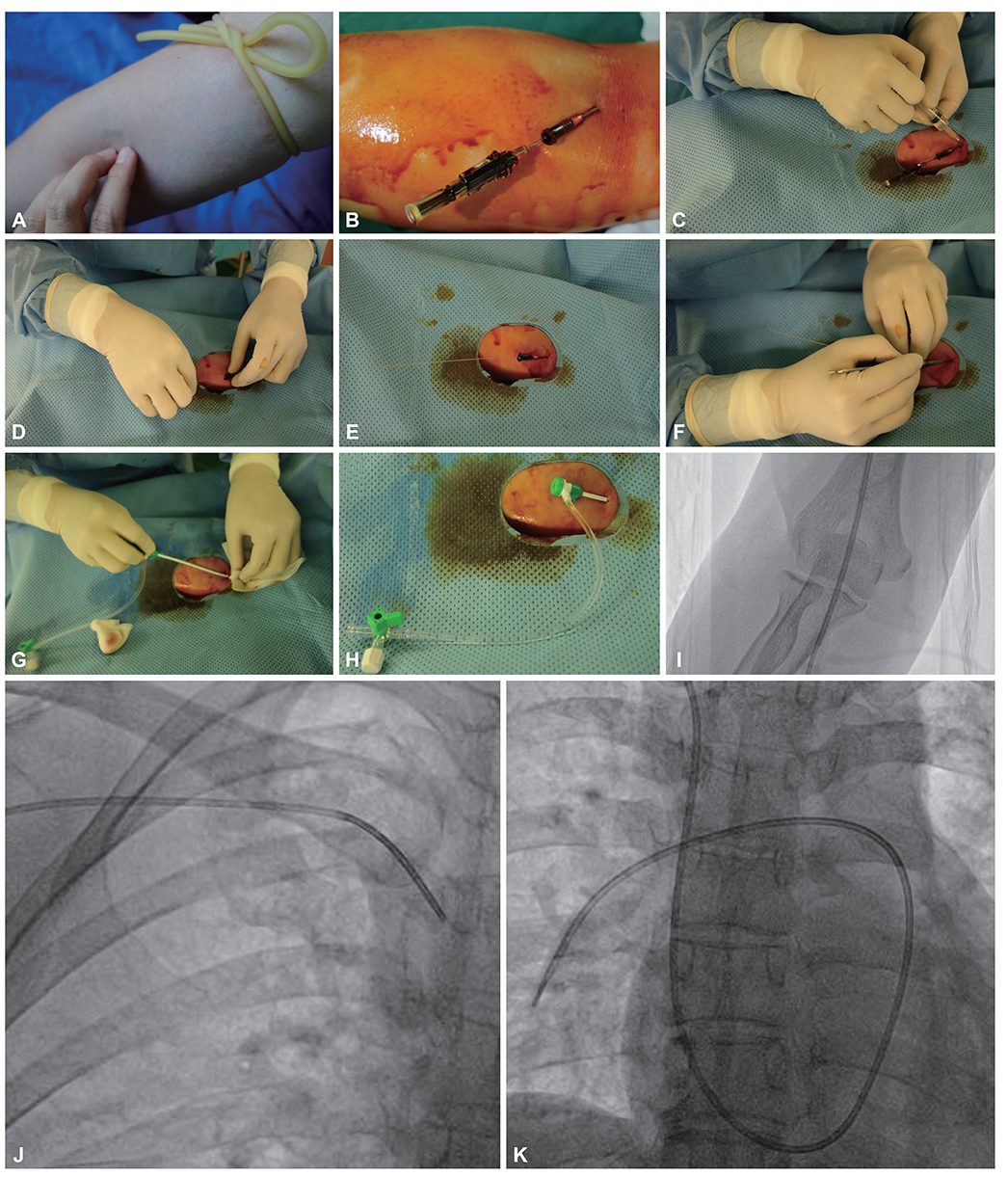Korean Circ J.
2016 Mar;46(2):207-212. 10.4070/kcj.2016.46.2.207.
Right Cardiac Catheterization Using the Antecubital Fossa Vein in Korean Patients
- Affiliations
-
- 1Division of Cardiology, Department of Internal Medicine, Pusan National University Yangsan Hospital, Yangsan, Korea. ptca82@gmail.com
- KMID: 2344472
- DOI: http://doi.org/10.4070/kcj.2016.46.2.207
Abstract
- BACKGROUND AND OBJECTIVES
Right heart catheterization is traditionally performed using a femoral vein approach that involves admission, bed rest, and risks of bleeding and hematoma. Recent studies have confirmed safety of the use of forearm vein for right cardiac catheterization. In the present study, we evaluated the feasibility of right cardiac catheterization via the antecubital fossa vein in Korean patients.
SUBJECTS AND METHODS
The medical records of all patients who underwent right heart catheterization at our hospital between January 2003 and December 2014 were reviewed retrospectively. Right cardiac catheterizations via the antecubital fossa vein and the femoral vein were compared in terms of demographic data (age, sex, weight, height, and body mass index), indications for right cardiac catheterization, and procedural and outcome data (initial success rate, procedure time, compression to ambulation time, and complications).
RESULTS
We reviewed 132 cases (antecubital fossa vein approach, n=37; femoral vein approach, n=95). The demographic data, initial success rate (100% vs. 100%) and procedure time (21.6±16.8 min vs. 25.6±12.6 min, p=0.14) were similar in both groups. The antecubital fossa vein group had a shorter mean compression to ambulation time than the femoral vein group (0.0 min vs. 201.2±48.1 min, p<0.01). No complications were observed in either group.
CONCLUSION
Our study indicated the ease of performance of right cardiac catheterization via the antecubital fossa vein. Thus, the antecubital fossa vein can be an alternative access site for right cardiac catheterization in Korean patients.
Keyword
MeSH Terms
Figure
Reference
-
1. Forssmann W. Die sondierung des rechten Herzens. Klin Wochenschr. 1929; 8:2085–2087.2. Cooper CJ, El-Shiekh RA, Cohen DJ, et al. Effect of transradial access on quality of life and cost of cardiac catheterization: a randomized comparison. Am Heart J. 1999; 138(3 Pt 1):430–436.3. Kiemeneij F, Laarman GJ, Odekerken D, Slagboom T, van der Wieken R. A randomized comparison of percutaneous transluminal coronary angioplasty by the radial, brachial and femoral approaches: the access study. J Am Coll Cardiol. 1997; 29:1269–1275.4. Cheng NJ, Ho WJ, Ko YS, et al. Percutaneous cardiac catheterization combining direct venipuncture of superficial forearm veins and transradial arterial approach-a feasibility approach. Acta Cardiol Sin. 2003; 19:159–164.5. Gilchrist IC, Moyer CD, Gascho JA. Transradial right and left heart catheterizations: a comparison to traditional femoral approach. Catheter Cardiovasc Interv. 2006; 67:585–588.6. Lo TS, Buch AN, Hall IR, Hildick-Smith DJ, Nolan J. Percutaneous left and right heart catheterization in fully anticoagulated patients utilizing the radial artery and forearm vein: a two-center experience. J Interv Cardiol. 2006; 19:258–263.7. Yang CH, Guo GB, Yip HK, et al. Bilateral cardiac catheterizations: the safety and feasibility of a superficial forearm venous and transradial arterial approach. Int Heart J. 2006; 47:21–27.8. Shah S, Boyd G, Pyne CT, et al. Right heart catheterization using antecubital venous access: feasibility, safety and adoption rate in a tertiary center. Catheter Cardiovasc Interv. 2014; 84:70–74.9. Gilchrist IC, Kharabsheh S, Nickolaus MJ, Reddy R. Radial approach to right heart catheterization: early experience with a promising technique. Catheter Cardiovasc Interv. 2002; 55:20–22.10. Rogers T, Lederman RJ. Right heart catheterization from the arm: back to first principles. Catheter Cardiovasc Interv. 2014; 84:75–76.
- Full Text Links
- Actions
-
Cited
- CITED
-
- Close
- Share
- Similar articles
-
- Clinical Analysis of Arteriovenous Fistula Using Perforating Vein on Antecubital Fossa
- Erratum: Right Cardiac Catheterization Using the Antecubital Fossa Vein in Korean Patients
- Pulsed Wave and Color Doppler Echocardiography and Cardiac Catheterization Findings in Bilateral Pulmonary Vein Stenosis
- Bilateral hydrothorax and cardiac tamponade after right subclavian vein catheterization: A case report
- Blood Gas Analysis of the Spermatic Vein and Antecubital Vein in the Patients with Bilateral Varicocele


